Fine, straight hair can be both a blessing and a challenge. While we love its silky smoothness, it often lacks volume and can fall flat throughout the day. That’s why finding the right hairstyle is crucial for those of us with this hair type.
We’ve gathered the most flattering hairstyles specifically designed to give fine, straight hair the volume and dimension it craves. From pixie cuts that create the illusion of thickness to strategically placed layers that add movement, these styles will transform your locks from limp to lively. Whether you’re looking for a dramatic change or subtle enhancement, our expert-approved hairstyles will help you make the most of your fine, straight hair.
10 Best Hairstyles for Fine Straight Hair That Add Volume and Style
1. Textured Bob with Side Swept Bangs
Textured bobs create instant volume for fine straight hair by removing weight while maintaining movement. The blunt cut at the bottom provides an illusion of thickness, while side-swept bangs add softness around the face. Styling this look requires minimal effort—simply apply a volumizing mousse to damp hair and blow dry with a round brush. For extra texture, finish with a light spritz of texturizing spray at the roots.
2. Layered Lob (Long Bob)
Lobs work wonderfully for fine hair types as they offer versatility without sacrificing volume. Strategic layers throughout create dimension and movement, preventing the flat appearance that often challenges fine straight hair. The shoulder-length cut balances perfectly between too short and too long, allowing enough weight for the hair to lay nicely while still maintaining bounce. Using a flat iron to slightly flip the ends will enhance this style’s ever-changing appearance.
3. Pixie Cut with Longer Top
Pixie cuts dramatically transform fine straight hair by creating the appearance of thickness through contrast. Keeping the top slightly longer allows for versatile styling options while the shorter sides create a foundation for volume. This low-maintenance style works exceptionally well for those with delicate facial features, highlighting cheekbones and eyes. A small amount of texturizing paste applied to the longer sections will create definition without weighing hair down.
4. Blunt Mid-Length Cut with Curtain Bangs
Blunt cuts create the appearance of thicker hair instantly by forming a solid line at the ends. Adding curtain bangs to this style frames the face beautifully while creating movement around the forehead. The combination works particularly well for fine straight hair as it maximizes density where it matters most. Blow drying with a large round brush will accentuate the smooth, voluminous effect of this sophisticated style.
5. Shaggy Layers with Face-Framing Pieces
Shaggy layers breathe life into fine straight hair by creating natural texture and movement throughout. The varied lengths prevent hair from lying flat against the head, creating natural volume without requiring excessive styling. Face-framing pieces brighten the complexion and draw attention to your best features. Scrunching in a lightweight volumizing foam while hair is damp will enhance the textured effect without creating stiffness.
6. Asymmetrical Angled Bob
Asymmetrical bobs add instant edge and volume to fine straight hair through their architectural structure. The angle creates natural movement and dimension, making hair appear thicker than it actually is. This style particularly flatters oval and heart-shaped faces, creating balance and drawing attention to the jawline. For maximum impact, blow dry with a paddle brush, directing the hair toward the longer side to emphasize the dramatic angle.
7. Short Layered Cut with Wispy Ends
Short layered cuts remove excess weight from fine hair while maintaining a feminine appearance through wispy ends. The varying lengths create natural volume at the crown while the textured ends prevent the boxy appearance that can sometimes occur with shorter styles. This versatile cut works well for active lifestyles as it requires minimal styling—simply apply a root-lifting spray and rough dry for instant volume.
8. One-Length Shoulder Cut with Deep Side Part
One-length cuts at shoulder height provide the perfect canvas for fine straight hair by creating a solid perimeter that appears thicker. Adding a deep side part instantly creates volume at the crown and allows for versatile styling options. This classic style transitions beautifully from day to evening looks with minimal effort. Blow drying with a round brush while alternating the direction creates natural movement that lasts throughout the day.
9. French Bob with Micro Bangs
French bobs hitting just below the chin create a chic, sophisticated look that works particularly well for fine straight hair. The precise cutting technique emphasizes clean lines, making hair appear thicker and more defined. Adding micro bangs brings attention to the eyes while balancing facial proportions. This style requires minimal product—just a light-hold mousse applied to damp hair before air drying will maintain the sleek, polished appearance.
10. Long Layers with Invisible Graduation
Long layers with invisible graduation offer the best of both worlds for those who prefer maintaining length while adding volume. The subtle layering technique removes bulk from the right places while maintaining the appearance of thickness throughout. This style works particularly well for oval and long face shapes, softening angles and creating balance. Applying a volumizing spray at the roots before blow drying upside down will maximize the volumizing effect of this versatile cut.
Understanding Fine Straight Hair: Challenges and Opportunities
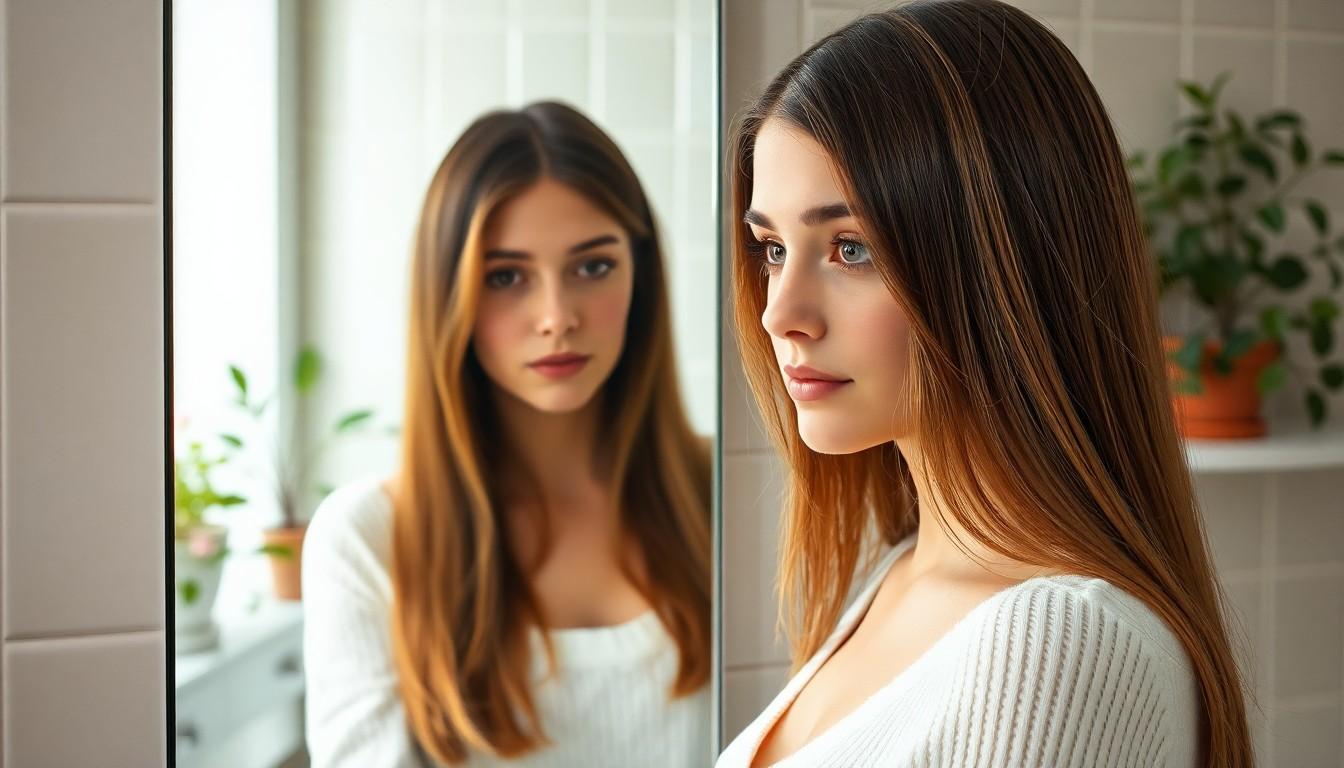
Characteristics of Fine Straight Hair
Fine straight hair typically lacks natural volume and features a thin texture with an exceptionally smooth surface. This hair type tends to lie flat against the head, creating a sleek appearance that can sometimes appear limp without proper styling. The silky-smooth surface allows natural oils to travel down the hair shaft more efficiently than in other hair types. Many people with fine straight hair notice that their style loses shape quickly throughout the day. Identifying these inherent characteristics is the first step to finding hairstyles that work with—rather than against—fine straight hair’s natural tendencies.
Common Styling Challenges
Greasiness poses a important challenge for those with fine straight hair as oils travel easily down the smooth hair shaft, causing strands to clump together and appear dull. Volume creation remains difficult due to the thin texture and natural tendency to lie flat, particularly at the roots where lift is most desired. Texture issues frequently arise because the smooth surface resists holding styles or waves, making it challenging to create depth and dimension that many hairstyles require. Maintaining hairstyles throughout the day can be frustrating as fine straight hair often falls flat quickly after styling. Heat styling sometimes damages fine hair more visibly than thicker hair types, requiring extra care when using tools like curling irons or straighteners.
The Perfect Bob: A Classic Choice for Fine Straight Hair
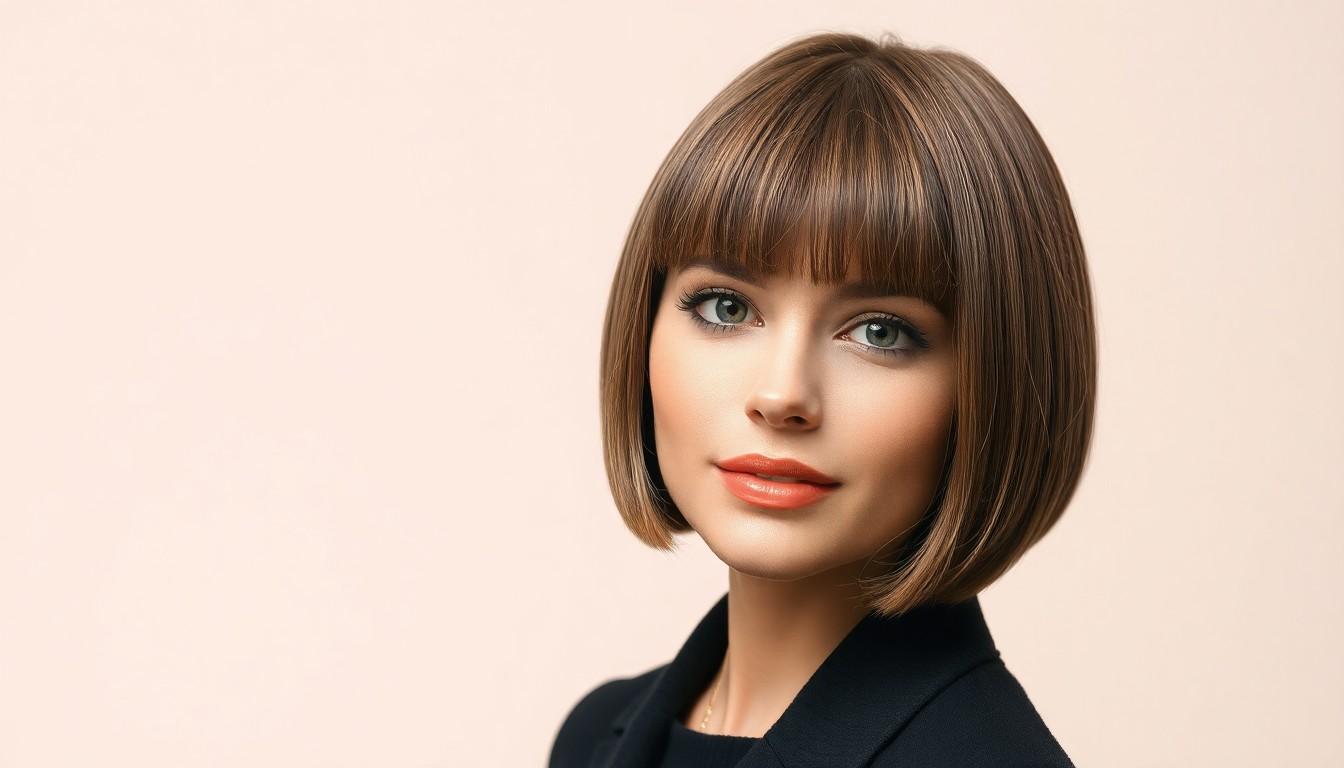
The bob haircut remains a timeless option for those with fine straight hair. This versatile style creates the illusion of thickness while maintaining a chic, polished appearance.
Blunt Bob with Sharp Edges
A blunt bob with sharp edges stands as an excellent choice for fine straight hair types. This precision cut avoids excessive layers that can make already fine hair appear thinner. The clean, sharp lines of a blunt bob create definition along the ends, giving the illusion of more hair and greater density. Many stylists recommend this option specifically because it frames the face effectively while maximizing the appearance of your hair’s volume. The sharp edges provide structure and enhance the natural movement of straight hair, allowing it to swing beautifully with minimal styling effort.
Layered Bob for Added Movement
While excessive layering can sometimes thin out fine hair, a strategically layered bob adds beneficial movement and texture. The key lies in careful placement of subtle layers rather than aggressive thinning. Mid-length or chin-length bobs with targeted layers around the chin and collarbone area enhance dimension without sacrificing precious volume. These thoughtful layers prevent the flat appearance that often challenges those with fine straight hair. For optimal results, ask your stylist for layers that add bounce and shape while maintaining the overall integrity and fullness of your bob. This approach transforms potentially limp strands into a ever-changing, voluminous style that moves naturally throughout the day.
Pixie Cuts That Work Wonders for Thin Strands

Fine straight hair can truly shine with the right pixie cut. These short styles create the illusion of fullness while maintaining a chic, low-maintenance look perfect for those with thinner strands.
Short Pixie Cut
The classic short pixie is an excellent choice for fine straight hair that needs volume. This style features shorter sides with slightly longer hair on top and a fringe that frames your face beautifully. Your bone structure becomes more pronounced with this cut, adding a feminine touch even though its shorter length. For the best results, opt for a side-parted fringe that enhances the overall elegance of this effortless style. Many clients find this cut requires minimal styling time while maximizing their hair’s natural texture.
Textured Pixie for Modern Appeal
A textured pixie cut transforms fine straight hair by creating the appearance of thickness and dimension. Strategic layers throughout this style provide natural volume that fine hair often lacks. Styling becomes simple yet effective when you scrunch your hair while it dries or apply a texturizing spray to enhance definition. The varied lengths in a textured pixie prevent the flat appearance that often plagues thin strands. Professional stylists recommend this cut specifically for its ability to make hair look fuller without requiring extensive daily styling.
Long Pixie with Side-Swept Bangs
The long pixie with side-swept bangs offers versatility that works perfectly for fine straight hair. This modified pixie maintains the short, cropped sides of traditional versions while leaving more length on top for styling options. Side-swept bangs frame your face softly and add a feminine quality that balances the edginess of shorter cuts. Maintaining this style requires minimal effort—just apply a lightweight volumizing product to keep those side-swept bangs in place and lift the longer top sections. Fine hair benefits from this cut’s built-in structure that creates the appearance of more substantial locks without weighing them down.
Shoulder-Length Cuts That Create Illusion of Thickness

Shoulder-length cuts offer the perfect balance between length and volume for those with fine straight hair. These styles create clean lines that enhance the appearance of thickness while remaining versatile enough for various styling options.
The Lob (Long Bob) with Subtle Layers
The long bob, commonly known as the “lob,” stands out as an ideal choice for fine straight hair seeking additional volume. This flattering cut works best when paired with subtle layers, particularly around the chin and collarbone area, which add texture and movement without thinning hair further. Maintaining a center parting with minimal layering helps preserve your hair’s natural thickness while creating a sleek, polished appearance that frames the face beautifully. We recommend avoiding excessive layers with this style, as they can counterintuitively make fine hair appear even thinner instead of achieving the desired fullness effect.
Blunt Mid-Length Cut with Curtain Bangs
A blunt mid-length cut creates a clean, precise line that instantly makes fine hair appear thicker and more substantial. This style works by forming a solid, defined edge that gives the illusion of density throughout the hair. Adding curtain bangs to this cut frames the face strategically while directing attention away from any areas of thinness, creating a fuller overall appearance. Curtain bangs, typically cut to sweep elegantly to the sides, add dimension to the hairstyle while requiring minimal maintenance. Professional stylists recommend keeping layering minimal with this cut to maintain maximum thickness at the ends where fine hair needs it most.
Strategic Bangs to Frame Your Face and Add Dimension
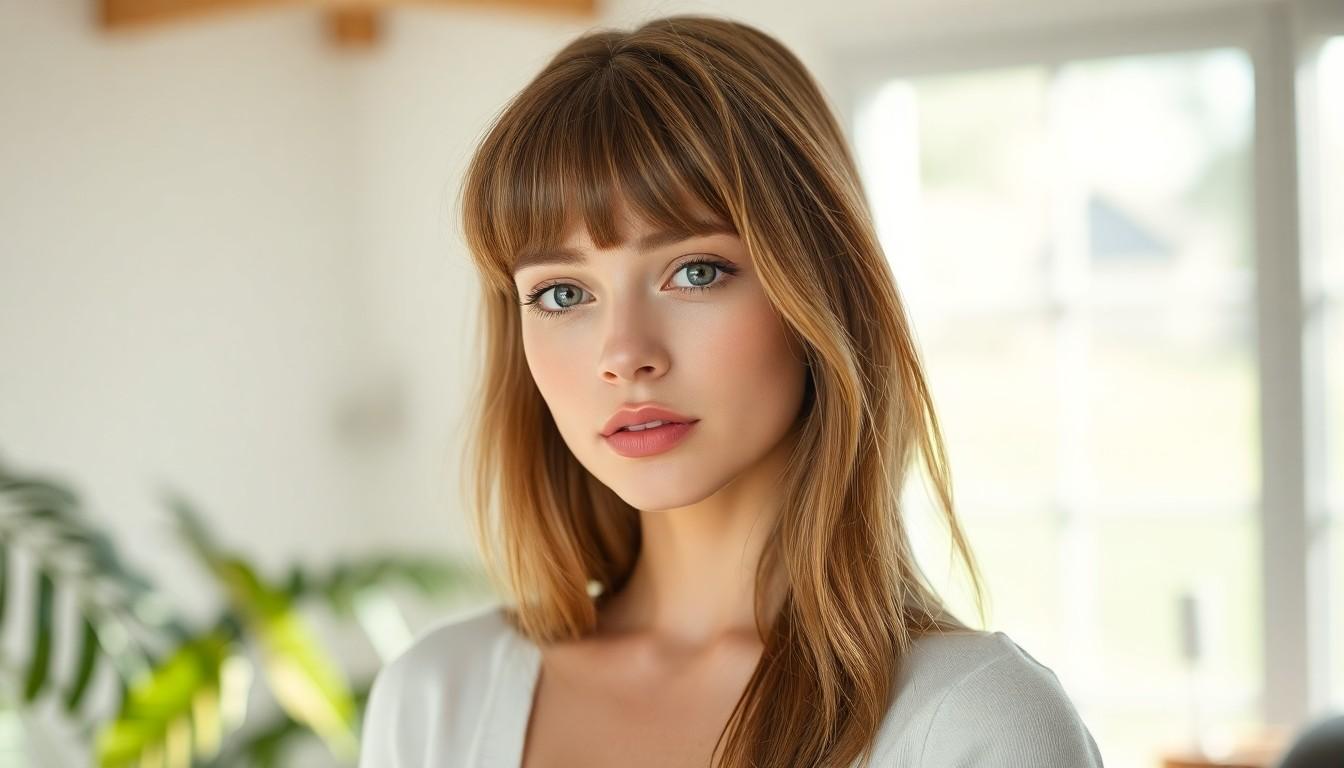
Adding bangs to fine straight hair creates instant dimension and frames your face beautifully. The right style of bangs can transform your look while giving the appearance of thicker, more voluminous hair.
Wispy Bangs for Lightweight Framing
Wispy bangs offer the perfect solution for those with fine straight hair seeking a subtle change. These delicate, feathery bangs add texture and dimension without weighing down your already fine hair. For the best results, keep them cut slightly above or at the eyebrow line to maintain a lightweight appearance. Textured or slightly layered wispy bangs prevent them from looking too dense, creating a soft frame that complements fine hair beautifully. This style works particularly well because it maintains the integrity of your hair while adding visual interest around your face.
Side-Swept Bangs for Versatility
Side-swept bangs create movement and versatility that’s ideal for fine straight hair. This adaptable style can be swept to either side, effectively distributing the weight of your bangs and preventing them from clumping together. Side-swept bangs also create the illusion of thicker hair by adding texture and volume around the face. The diagonal line formed by this style naturally draws attention across your face rather than highlighting any thinness in your hair. Many of our clients with fine hair find that side-swept bangs require minimal styling while maximizing their hair’s natural potential.
Face Shape Considerations for Bangs
Choosing bangs that complement your face shape dramatically improves the overall effect of your hairstyle. Round faces benefit from side-swept or angled bangs that create length and definition. Square faces appear softer with wispy or curved bangs that minimize angular features. Heart-shaped faces look balanced with side-swept bangs hitting just above the eyebrows. The strategic placement of bangs based on your unique face shape ensures the most flattering frame possible while improving your fine straight hair’s appearance.
Maintaining Bangs for Fine Hair
Regular trims every 2-3 weeks keep bangs looking fresh and prevent split ends in your fine hair. Light styling products make a important difference in bang maintenance without creating heaviness. Try using a small amount of light hold hairspray or texturizing spray to maintain shape throughout the day. Applying products with your fingertips rather than directly to the hair ensures even distribution without weighing down your delicate strands. Proper maintenance ensures your bangs continue to frame your face beautifully while adding the appearance of thickness to fine straight hair.
Layering Techniques Specifically for Fine Straight Hair
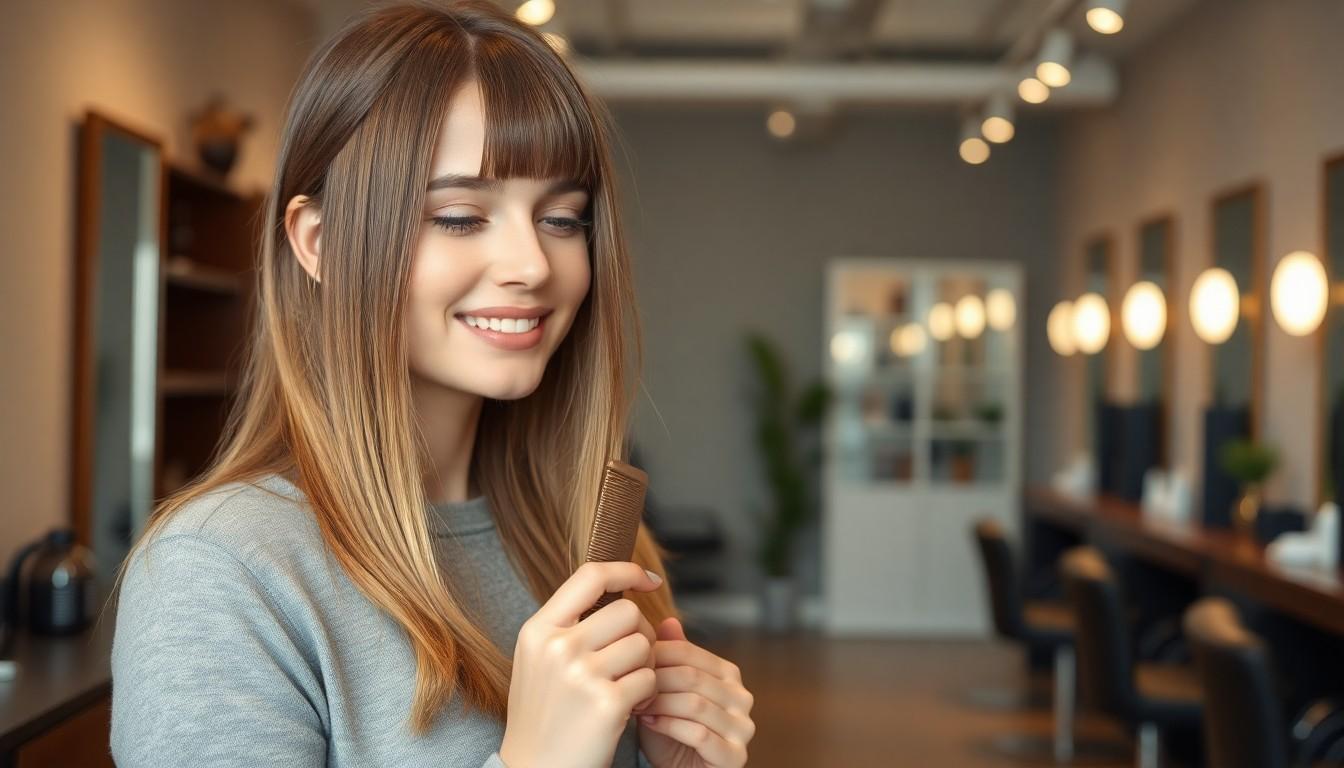
When it comes to fine straight hair, the right layering technique can make all the difference between flat, lifeless locks and a voluminous, ever-changing style. Strategic layering adds movement and dimension without sacrificing the hair’s natural thickness.
Invisible Layers for Subtle Volume
Invisible layers work wonders for fine straight hair by creating lift and texture without making the hair appear thinner. Also known as “internal layers,” this technique involves cutting layers within the hair rather than at the ends, creating hidden volume that’s distributed evenly throughout your style. The beauty of invisible layers lies in their subtlety—they add much-needed body to fine hair without creating visible steps or thinning out the ends. Your stylist will strategically remove bulk from the interior of your hair while maintaining the outer shape, resulting in natural movement and fullness that doesn’t compromise overall thickness.
Face-Framing Layers for Movement
Face-framing layers offer the perfect solution for adding movement and dimension to fine straight hair. These strategic layers typically begin around chin or collarbone length and gently cascade to frame your facial features. For fine straight hair, we recommend keeping these layers soft and minimal—think gentle graduation rather than choppy, dramatic cuts. Face-framing layers create the illusion of fuller hair by adding texture around your face where it matters most. They’re particularly effective when paired with styles like chin-length or collarbone-length bobs, creating flattering shapes that enhance your features while adding natural-looking movement to otherwise flat hair.
Avoid Excessive Layers
Fine straight hair requires a cautious approach to layering—excessive layers can actually make your hair appear even thinner. Instead of heavily layered cuts that remove too much weight, opt for more subtle layering techniques that maintain your hair’s natural thickness. Your stylist should focus on creating strategic layers that add movement without sacrificing density. Maintaining some weight at the ends helps create the appearance of thicker, healthier hair while still allowing for ever-changing movement throughout the style.
Updo Options That Won’t Fall Flat
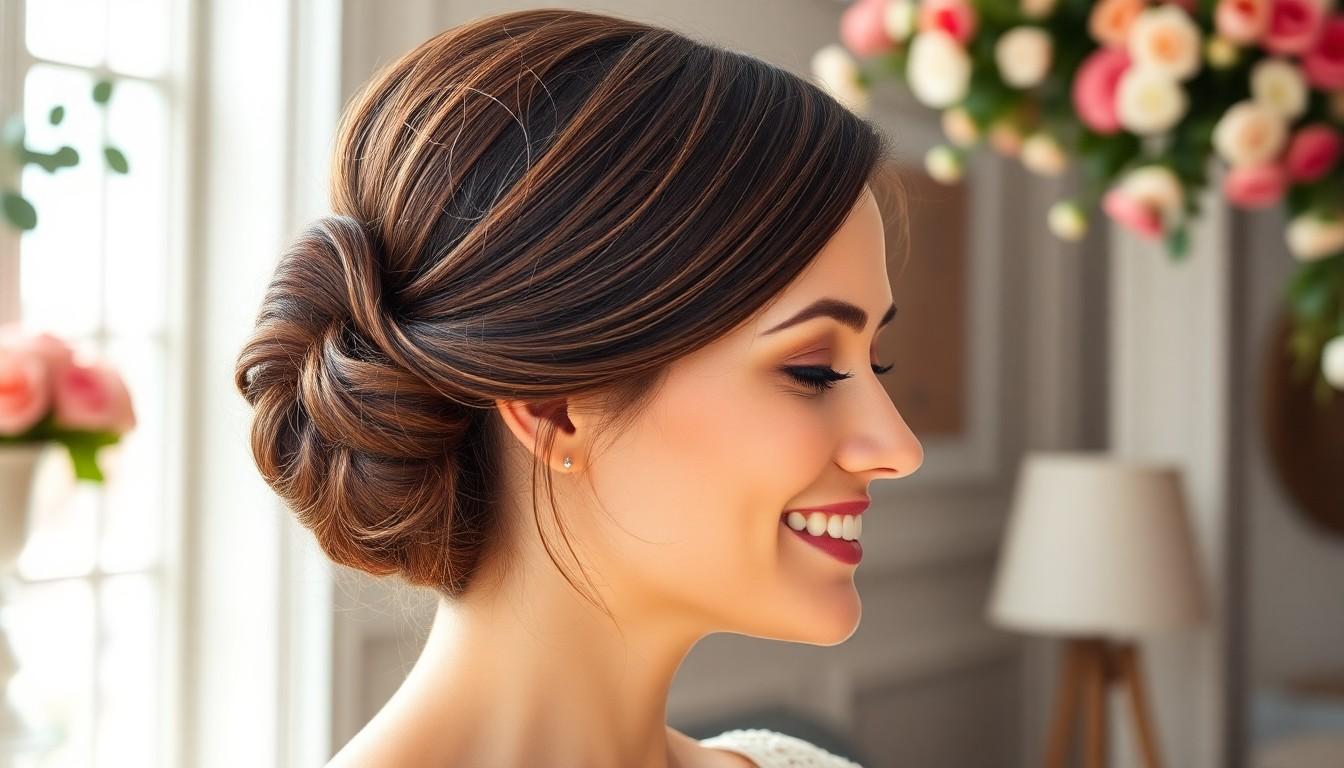
Fine straight hair can look stunning in updos with the right techniques to prevent flatness and add volume. These styles create elegant looks while maximizing your hair’s natural properties.
Textured Low Bun with Volume at Crown
Creating a textured low bun starts with building volume at the crown area—a crucial step for fine straight hair. Use volumizing shampoo and conditioner as your foundation, then apply root lift or thickening spray before styling to create instant body. While blow-drying, incorporate a round brush technique to lift hair from the roots, establishing height where fine hair typically falls flat. Once dry, gently backcomb the crown section to add substantial volume that supports your updo structure.
Gather your hair into a low bun position and secure with bobby pins rather than elastic bands which can compress volume. For enhanced texture, lightly tease sections before forming the bun to create a more substantial appearance. Leave a few face-framing strands loose around your face for a softer, more romantic finish that prevents the style from looking too severe—perfect for fine hair that benefits from softness and movement.
Half-Up Styles with Teased Roots
Half-up hairstyles offer versatile options that wonderfully complement fine straight hair by creating dimension and the illusion of fullness. Begin with hair care products specifically designed for fine hair types, which cleanse without weighing down strands. Apply a lightweight heat protectant before blow-drying, and finish with a cool shot setting to seal the cuticle and maximize volume.
Gentle teasing at the roots of the top section creates fundamental volume—use a fine-tooth comb for controlled backcombing without creating tangles or damage. Secure just the top section with a small elastic band or decorative clip, keeping the attachment light to prevent pulling down the volume you’ve created. For additional texture in the free-flowing lower section, try scrunching slightly damp hair before air drying or using a diffuser on low heat settings. This technique adds natural-looking movement without requiring heavy styling products that might flatten fine hair throughout the day.
Color Techniques That Create Depth and Dimension
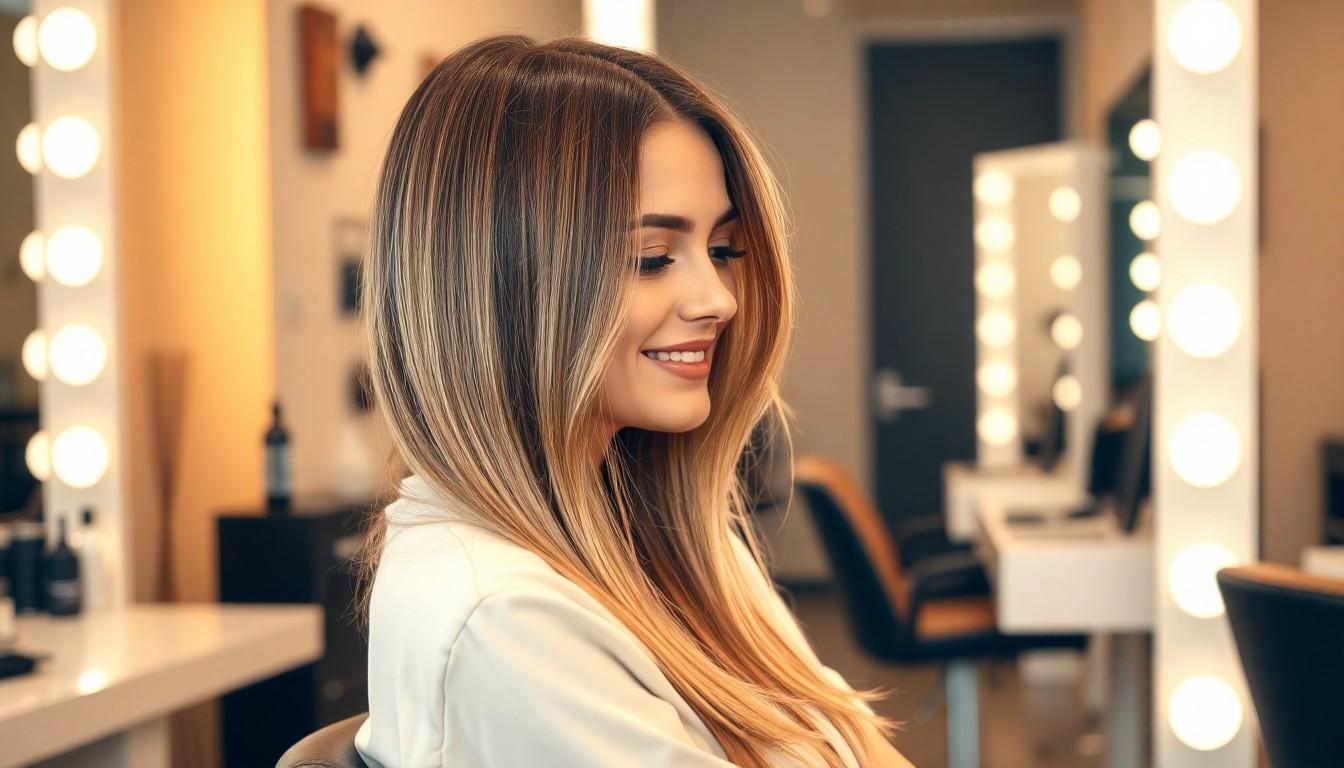
When it comes to fine straight hair, the right color techniques can completely transform your look by creating an illusion of thickness and dimension. Strategic coloring approaches can make a important difference in how voluminous your hair appears.
Balayage for Natural-Looking Dimension
Balayage offers a perfect solution for fine straight hair by adding subtle depth and movement without harsh lines. This freehand highlighting technique creates natural dimension by painting color onto the hair in sweeping motions. Unlike traditional foils, balayage provides softer transitions between colors, giving fine hair a multidimensional appearance that catches light at different points. The graduated effect draws the eye across various depths, creating visual interest and perceived thickness where none existed before. For best results, ask your colorist for soft, warm tones that complement your base color to maximize the dimensional effect while maintaining a natural look.
Shadow Roots for Added Visual Thickness
Shadow roots technique creates an immediate illusion of fuller hair by applying a darker shade at the root area. This strategic coloring method adds visual thickness by establishing contrast between the darker roots and lighter lengths. The depth at the scalp tricks the eye into seeing more volume right where fine hair typically lacks it most. Shadow roots also offer practical benefits for maintenance, allowing longer periods between salon visits as your natural roots grow in. We recommend selecting a root shade approximately two levels darker than your mid-lengths for the most flattering dimension that doesn’t appear too stark. This technique works beautifully when paired with balayage for a comprehensive approach to creating dimension in fine straight hair.
Styling Products and Tools Essential for Fine Straight Hair

When it comes to fine straight hair, the right styling products and tools can make all the difference between flat, limp locks and voluminous, vibrant styles. Selecting products specifically formulated for fine hair helps address common challenges while improving natural qualities.
Volumizing Products Worth Investing In
Volumizing products are game-changers for those with fine straight hair that tends to fall flat. Root lifters target the base of the hair shaft, creating lift and fullness right from the scalp where fine hair typically lacks volume. Lightweight volumizing shampoos and conditioners cleanse effectively without weighing hair down, making them essential for daily maintenance of fine strands. Texturizing sprays add instant body and dimension, transforming limp locks into fuller-looking styles with just a few spritzes. For combating greasiness (a common issue with fine hair), volumizing dry shampoos absorb excess oil while simultaneously adding texture and lift at the roots.
Heat Styling Tools and Techniques
Heat styling tools, when used correctly, can significantly enhance fine straight hair’s appearance. Blow dryers should be used on a cool setting to set styles and create volume without causing damage. Round brushes paired with blow dryers lift hair from the roots, creating the illusion of thicker, fuller hair—a technique particularly effective for fine-haired individuals. Straightening irons can achieve sleek, glossy finishes, but require sectioning hair into manageable parts and applying heat protectant beforehand to prevent damage. Professional stylists recommend keeping the temperature below 350°F when using hot tools on fine hair to maintain hair integrity. Heat protection sprays or serums should always be applied before any heat styling to create a protective barrier that preserves hair health and prevents the thinning that can occur with heat damage.
Maintenance Tips to Keep Your Fine Hair Looking Its Best
Finding the perfect hairstyle for fine straight hair doesn’t have to be a challenge. With the right cut techniques layering options and styling products we’ve shown how you can transform your delicate strands into a look with beautiful movement and dimension.
Remember that fine hair benefits from regular trims every 6-8 weeks to prevent breakage and maintain shape. Lightweight products applied strategically at the roots will give you that coveted lift without weighing hair down.
Whether you’ve chosen a textured bob pixie cut or long layers with invisible graduation your fine straight hair can look absolutely stunning. Embrace your hair’s natural qualities and you’ll discover just how versatile and beautiful it can be!
Frequently Asked Questions
What are the main challenges of having fine, straight hair?
Fine, straight hair often lacks natural volume and tends to lie flat against the head. It can appear greasy more quickly than other hair types, struggles to hold styles throughout the day, and can look limp despite its silky texture. These characteristics make it challenging to create and maintain volume, but with the right hairstyle choices, these issues can be effectively addressed.
Which bob style works best for fine straight hair?
Two bob styles work exceptionally well: the blunt bob with sharp edges creates definition and the appearance of thickness, while the layered bob adds movement and texture. Both styles keep weight at the bottom for volume. The textured bob with side-swept bangs and the asymmetrical angled bob are particularly flattering as they create dimension while maintaining the hair’s natural sleekness.
Why are pixie cuts recommended for fine straight hair?
Pixie cuts work wonders for fine straight hair because they remove excess weight that pulls hair down. The classic short pixie, textured pixie, and long pixie with side-swept bangs all maximize fine hair’s natural texture. These styles create the illusion of fullness by keeping hair short and light, allowing it to stand away from the scalp naturally.
How can shoulder-length cuts enhance fine straight hair?
Shoulder-length cuts like the long bob (lob) with subtle layers and blunt mid-length cuts with curtain bangs create the illusion of density without weighing hair down. These styles maintain enough length for versatility while incorporating elements that add volume and movement. The key is incorporating strategic layers or blunt ends that make hair appear thicker.
What bangs styles work best for fine straight hair?
Wispy bangs and side-swept bangs work best as they add dimension without removing too much weight from the hair. They frame the face while creating the appearance of volume at the crown. Curtain bangs are also excellent as they blend seamlessly with layers to create movement and texture, enhancing the hair’s natural body.
How can color techniques add volume to fine straight hair?
Balayage and shadow roots create visual dimension that makes fine hair appear thicker. Balayage adds natural-looking dimension without harsh lines, while shadow roots (applying a darker shade at the roots) create contrast that tricks the eye into seeing more volume. When combined, these techniques create multi-dimensional color that significantly enhances perceived thickness.
What styling products are essential for fine straight hair?
Volumizing products are essential—specifically lightweight volumizing shampoos and conditioners, root lifters, and texturizing sprays. Dry shampoo is also crucial as it absorbs excess oil while adding texture. The key is choosing products that add volume without weighing hair down, focusing on formulas specifically designed for fine hair.
How should heat styling tools be used on fine straight hair?
Use blow dryers with concentrator attachments and round brushes to create volume at the roots. Set tools to medium heat to prevent damage, and always use heat protectant products. Lift sections at the root while drying for maximum volume. For fine hair, less is more—avoid overusing flat irons which can make hair appear flatter.
Can layering help fine straight hair, and if so, how?
Yes, strategic layering helps fine straight hair by removing weight that pulls hair down while creating movement and dimension. Invisible graduation and face-framing pieces add the appearance of volume without creating obvious layers. The key is subtle layering that maintains density at the ends while adding texture throughout the style.
How can I maintain volume in my fine straight hair throughout the day?
Use a volumizing mousse or spray on damp hair before styling. Flip your head upside down when blow-drying to create lift at the roots. Carry dry shampoo for midday refreshes. Avoid touching your hair frequently as natural oils from fingers can weigh it down. Consider using velcro rollers at the crown for 10 minutes before leaving home for lasting volume.







